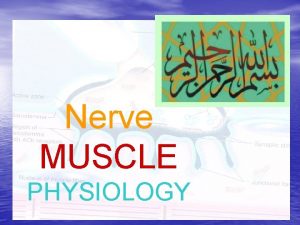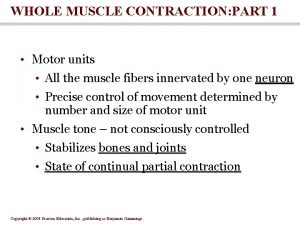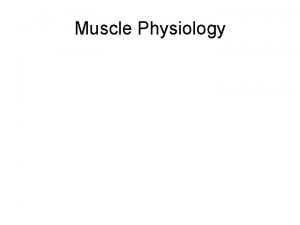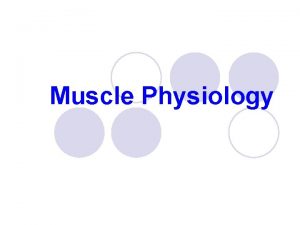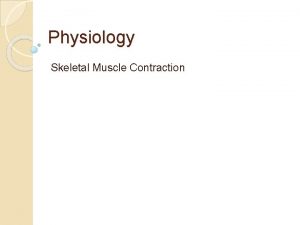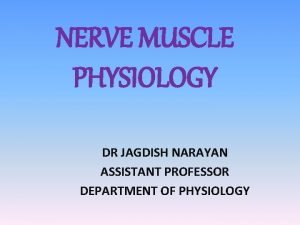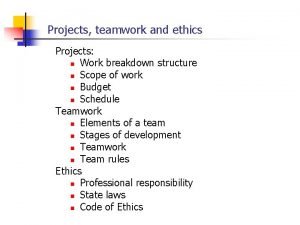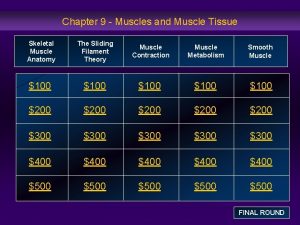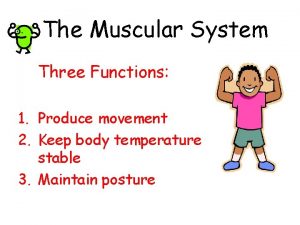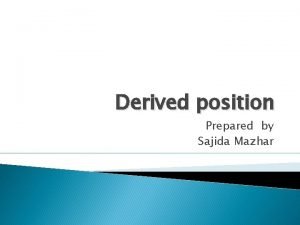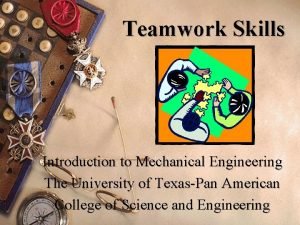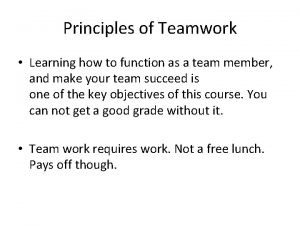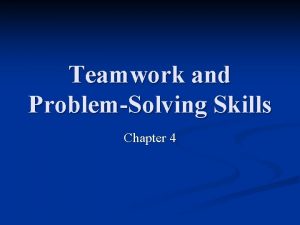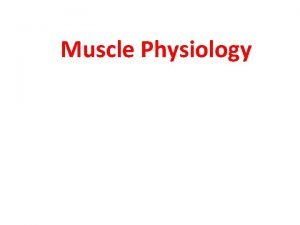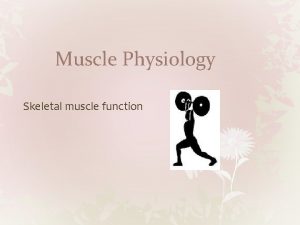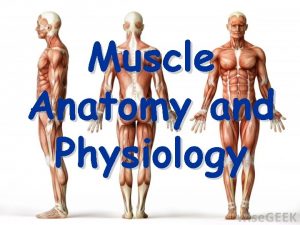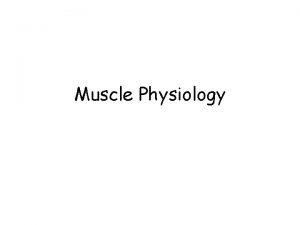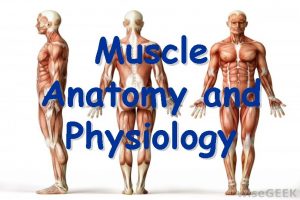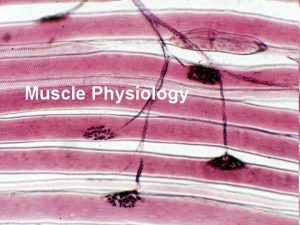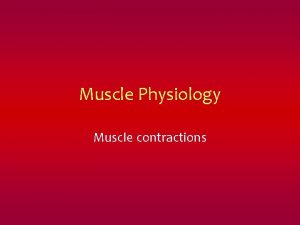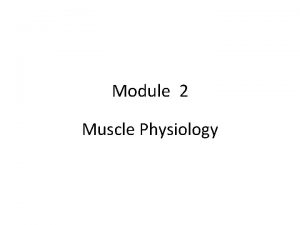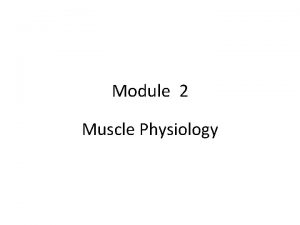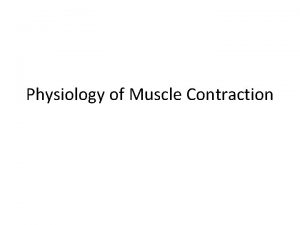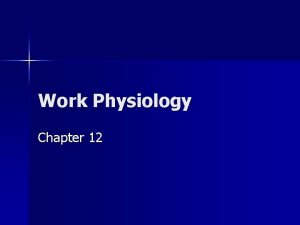Muscle Physiology Muscles at Work Muscle Teamwork Muscles

































- Slides: 33

Muscle Physiology Muscles at Work

Muscle Teamwork Muscles work in perfect synchrony. When one muscle contracts to move a bone another relaxes allowing the bone to move. The muscle(s) that contracts and causes movement is the agonist or prime mover while the muscle(s) opposing the action is the antagonist. Inter-muscle coordination and reciprocal innervation enable the agonist-antagonist relationship to occur throughout the body allowing for smooth fluid movement.

The Anatomy of Skeletal Muscle t Muscle fibre looking outward: v Perimysium 4 Binds muscle fibres together Muscle fibre Perimysium v Epimysium 4 Sheath enveloping entire muscle t Muscle fibre looking inward: Epimysium v Endomysium 4 Sheath of connective tissue surrounding muscle fibre v Sarcolemma 4 Contains cytoplasm (sarcoplasm) v Myofibrils 4 Contain actin and myosin v Sarcomeres 4 Contains myosin and actin Endomysium Muscle belly Tendon

Muscle Fibre Epimysium Perimysium Z line Sarcomere Z line Muscle belly Tendon Muscle Fibre Thick filament Thin filament Sarcomere Sarcolemma Sarcoplasmic reticulum ©Thompson Educational Publishing, Inc. 2003. All material is copyright protected. It is illegal to copy any of this material. This material may be used only in a course of study in which Exercise Science: An Introduction to Health and Physical Education (Temertzoglou/Challen) is the required textbook. Myofibril

Inside the Muscle Skeletal muscle is made up of numerous cylinder-shaped cells called muscle fibres. Each fibre is made up of a number of myofibrils. Within each myofibril a number of contractile units, called sacromeres. Sacromeres are organized in series (end to end) throughout the length of the myofibril.

Sarcomeres Each sarcomere is made up of two types of protein: Each myosin is surrounded by six actin filaments. Projecting from each myosin filament are tiny “heads” that will form myosin bridges. Actin filament Myosin filament

Magnification of a Sarcomeres

Muscle Theory Sarcomere Contraction

Contracting Muscle When a signal comes from the motor nerve (via acetylcholine) it causes the sacroplasmic recticulum that surrounds the myofibrils to release calcium ions.

Contracting Muscle The calcium finds it way to the attachment sites on the tropomyosin causing it to swivel and exposing the bonding sites on the actin to be exposed.

Contracting Muscle At the same time, available ATP attaches to the myosin head giving it the energy it needs to move.

Contracting Muscle The myosin “heads” moves to form a myosin bridge that temporarily attaches to the bonding site on the actin filament in a process called cross-bridge formation.

Contracting Muscle As ATP is broken down the actin filaments rotates and “pulls” the myosin filament causing it to shorten.

Contracting Muscle This process, called the sliding filament theory, results in the shortening of the sarcomere and muscle contraction.

Contracting Muscle Over and over the cross bridges attach, detach and reattach in rapid succession causing the filaments to overlap. The nervous system is capable of activating cross bridge formation at a rate of 7 - 50 per second. Forming and breaking a cross-bridge shortens a sacromere by about 0. 04%

Optimal Cross Bridge Formation Actin and Myosin Cross linking Sarcomere Review

Optimal Cross Bridge Formation In order for muscles to move efficiently, sacromeres should move an optimal distance apart. • For muscle contraction: optimal distance is (0. 00190. 0022 mm). At this distance an optimal number of cross bridges are formed. • If the sarcomeres are stretched farther apart than optimal distance fewer cross bridges can form less force produced • If the sarcomeres are too close together cross bridges interfere with one another as they form less force produced

Optimal Joint Angle The distance between sarcomeres is dependent on the stretch of the muscle and the position of the joint To produce an efficient movement of a joint, cross bridge formation must be optimally placed - reaching far enough but not too far. • Maximal muscle force occurs at optimal muscle length • Maximal muscle force occurs at optimal joint angle • Optimal joint angle occurs at optimal muscle length

Optimal Joint Angle As the joint moves through its range of motion, the muscles connecting the two segments of the joint will move from a stretched position to a compressed position and at some point in the movement will pass through a position called the optimum joint angle.

Optimal Joint Angle The optimum joint angle provides the proper muscle length for maximum force development. The optimum joint angle enables the joint to move smoothly and efficiently as the muscle contracts. Muscle tension during elbow flexion at constant speed

Optimal Joint Angle Stand bend both knees. Squat as low as you can. Stand up slowly. As you are standing, is there a phase at which it is easier or more difficult to contract your muscles. What do you think the optimal joint angle of your knee is (approximately)?

Optimal Joint Angle How can you use this knowledge of the optimal joint angle of your knee to maximize your ability in a sport? Brainstorm the skills that utilize knee flexion and extension in different sports…

Optimal Joint Angle There is an optimal joint angle for each movement of a joint. Knowledge of the joint angle at which maximum force can be developed is important in the development of optimal biomechanics of movement. Athletes use the study of biomechanics to find ways to manipulate the optimum joint angle in order to produce the most efficient motion and produce maximum force.

Muscle Fibre Types Muscle fibres are distinguished by their ability to reach maximum tension. Muscle fibres can be divided into three categories: • Fast twitch (FT or Type II) also called white fibres based on their microscopic appearance • Slow twitch (ST or Type I) also called red fibres based on their microscopic appearance • Intermediate which possess characteristics of both fast and slow twitch.

Muscle Fibre Types Fast twitch fibres are anaerobic (do not require oxygen), are larger, fatigue faster, and contract faster than slow twitch fibres FT fibres are used for actions that are short and require quick bursts of power and energy. FT fibres are responsible for speedpower activities such as sprinting, throwing and jumping

Muscle Fibre Types Slow twitch fibres are aerobic - they rely on oxygen for continued contraction. ST fibres are slower contracting, and more fatigue -resistant than FT fibres ST fibres are used in events that require endurance such as long distance running, swimming or cycling. (Low-power activities)

Muscle Fibre Types Intermediate muscle fibres posses characteristics of both fast and slow twitch. Intermediate muscle fibres contract more quickly and produce more force than slow twitch but contract more slowly and produce less force than fast twitch. They are more fatigue resistant than fast twitch but less fatigue resistant than slow twitch.

How Muscle Fibre Types are Used Most skeletal muscles contain both FT and ST fibres with the amount of each varying from muscle to muscle and from individual to individual. The amount of effort usually determines the type of muscle fibre that is used to generate movement. Muscles responsible for maintaining posture have a large number of ST fibres and are usually organized in large motor units. Muscles used mostly for quick, accurate movement (ex: arms and hands) contain mainly FT fibres, grouped in small motor units

100 80 % Active Muscle Fibres How Muscle Fibre Types are Used Fast Twitch – 100% Intermediate – 77% 60 40 Slow Twitch – 38% 20 0 Exercise Intensity

How Muscle Fibre Types are Used Event Slow Twitch - Type I Fast Twitch - Type 2 100 metre Sprint Low High 800 -m Run High Marathon High Low Olympic Weightlifting Low High Barbell Squat High Soccer High Football Wide Receiver Low High Football Lineman High Basketball Low High Distance Cycling High Low

Muscle Types and Training The muscle fibre composition of an individual is determined through heredity and cannot be altered. Most people have a 50 -50 distribution of FT and ST muscle fibres. While training will improve the muscle fibres that you have, the transformation of a fibre from one type to another as the result of training does not occur. Since the type of muscle fibre that a person has is inherited individuals are suited to some activities and not others.

Muscle Types and Training Researchers have measured the number of FT and ST muscle cells in different types of elite athletes. Slow-Twitch % Fast-Twitch % Untrained person 48 52 Cycling 61 39 Middle-distance runner 59 41 Sprinter 26 74 Ball Sports 46 54 Sport

Muscle Types and Training With appropriate training, slow twitch muscles can become “faster” or more anaerobic while fast twitch fibres can become “slower” or more aerobic. The way in which a person trains determines the type of fibre developed or improved. Slow, low intensity work will develop the slow twitch fibres High intensity power and speed activities will develop the fast twitch fibres. Note: Even with training, the basic type of muscle remains unchanged.
 Teamwork poem class 6
Teamwork poem class 6 T tubule
T tubule Physiology of muscle contraction
Physiology of muscle contraction Muscle physiology
Muscle physiology Muscle twitch
Muscle twitch Muscle contracts
Muscle contracts Nerve muscle physiology
Nerve muscle physiology Expected behavior in work immersion
Expected behavior in work immersion Work immersion matrix
Work immersion matrix Code of ethics teamwork
Code of ethics teamwork Reflection for work meeting
Reflection for work meeting Muscles and muscle tissue chapter 9
Muscles and muscle tissue chapter 9 Different types of muscle cells
Different types of muscle cells Toe dancers muscle a two bellied muscle of the calf
Toe dancers muscle a two bellied muscle of the calf How do muscles work in pairs
How do muscles work in pairs Stride lying position
Stride lying position Types of muscle work
Types of muscle work Teamwork animals working together
Teamwork animals working together Teamwork divides the task and multiplies the success author
Teamwork divides the task and multiplies the success author Motivational speech on teamwork
Motivational speech on teamwork Teamwork in action
Teamwork in action Teamwork in engineering
Teamwork in engineering Teamwork training module
Teamwork training module Teamwork learning objectives
Teamwork learning objectives Principles of effective teamwork
Principles of effective teamwork Principles of teamwork
Principles of teamwork Qsen core competencies
Qsen core competencies How do different personalities affect teamwork?
How do different personalities affect teamwork? What comes your mind
What comes your mind Teamwork and collaboration vocabulary
Teamwork and collaboration vocabulary Teamwork in engineering
Teamwork in engineering The process of making an expectation a reality is
The process of making an expectation a reality is Conculision
Conculision Interdisciplinary teamwork
Interdisciplinary teamwork

